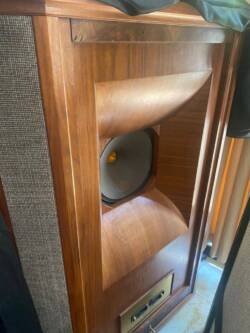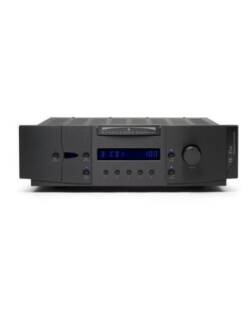Spread Spectrum Tech. Ampzilla 2000 2nd Edition Monoblocks + Preamplifier
Original price was: R330,000.00.R168,000.00Current price is: R168,000.00.
What a bargain and amazing sound!!!
When I reviewed the original Ampzilla 2000 monoblock power amplifers in February, 2009, I reported on a very good sounding, well made component that had just enough of its own character that it was highly recommended but not without reservations. In hindsight now, comparing its sound to several other currently made amplifiers, its particular character was quite small and more acceptable than the competition.
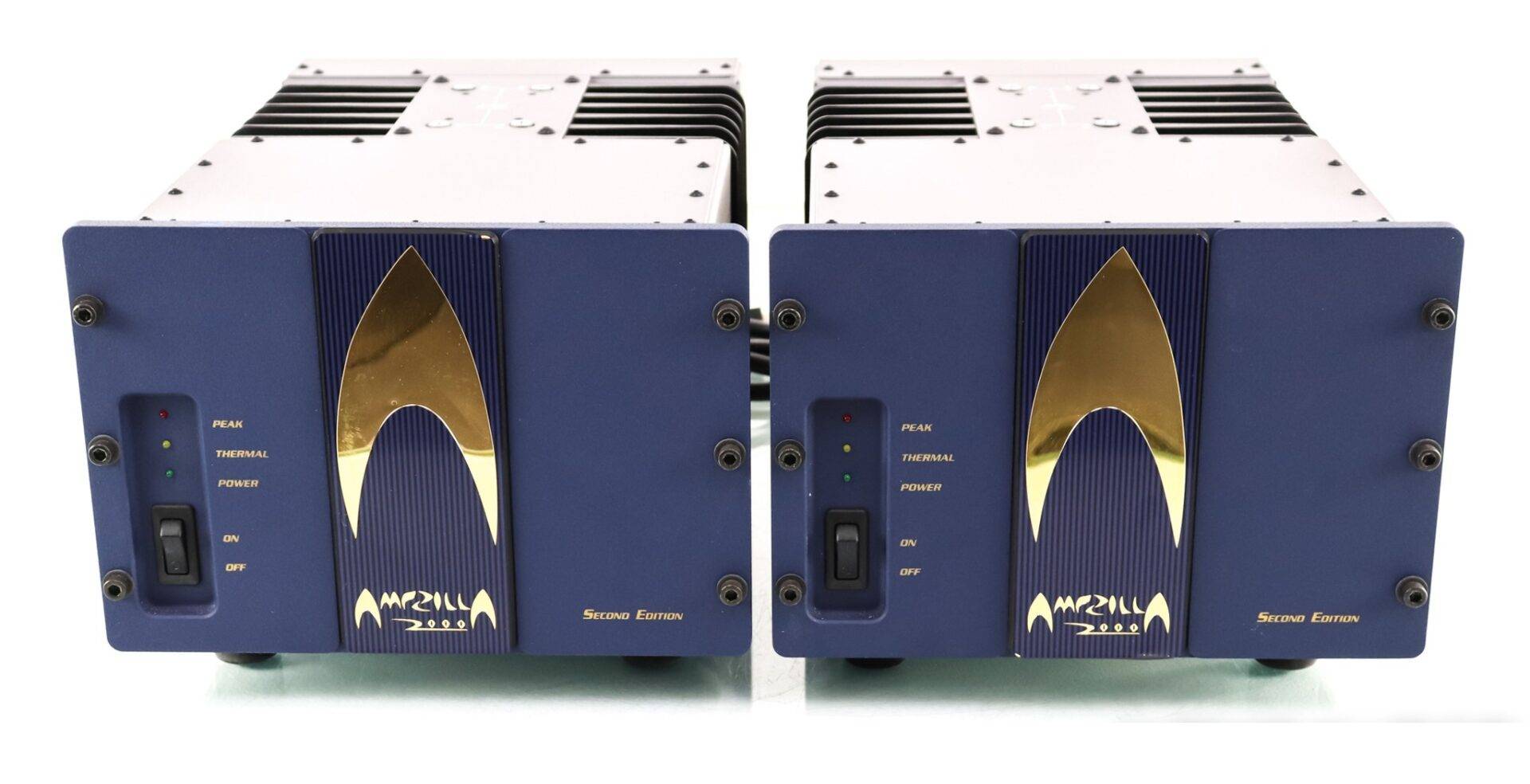
The new $8495/pair Ampzilla 2000 Second Edition sees an increase of power from 200 to 300 Watts per channel, while the weight is still very manageable at 52 pounds per chassis. I have had Class D amps that run warmer at low volume levels. When used at high volume levels, the heatsinks get warm. The permanently attached power cord eliminates the option to spend a lot of time and money experimenting with after-market power cords. There are RCA and XLR inputs and 2 pairs of speaker binding posts on each amplifier. There is no remote trigger, and I use a PS Audio Quintet to turn on and turn off the amplifiers remotely. The design is solid industrial but not at all cheap looking. Almost the entire front half of the chassis is taken up by a massive 1200VA power transformer.
My pair (owned, not borrowed or loaned) has a black faceplate and grey chassis. I was a little concerned about the large reflective “A” logo on the front panel. You know, the big Star Trek-looking insignia. This is not a problem, eyesore, intrusion, or distraction. With the amplifiers near the speakers, the reflection from this logo is just black and is only noticeable if I look directly at them. I actually like it. So no worries on that score.
Other components on hand during the audition included a SOTA Cosmos IV vacuum turntable with Triplanar VII u2 tonearm, Basis 2500 Signature turntable with Vector 4 and MØRCH DP-8 tonearms, Miyajima Kansui and Shilabe phono cartridges, Benz LP-S, ZYX Omega-S and UNIverse phono cartridges, Whest PS.30RDT Special Edition phono preamplifier, Bob’s Devices CineMag 1131 “Blue” step-up transformer, Mark Levinson 326S preamplifier with phono, Prism Orpheus Digital Interface and Berkeley Alpha DAC Series 2 with custom Windows 7 computer/music server, KingRex UC384 24bit 384kHz USB to SPDIF digital to digital converter, YG Acoustics Kipod II Signature Main Modules speakers, Dali Mentor 5 speakers (from the home theater system), and Gallo TR-3 subwoofers. Power amplifiers included Mark Levinson 532H, Modwright KWA 150 Signature Edition, Manley Snappers, and Classe CT-M300s. Interconnects and speaker cables are mostly Mogami. All front end components receive their AC power from a PS Audio AV-5000 power conditioner which is connected to the wall power with either PS Audio PerfectWave AC-10 power cord or Shunyata Python CX power cord. Other Shunyata Python CX and Black Mamba CX power cords are used elsewhere in the system, and I use Jerry’s DIY power cords on the music computer and Levinson preamp. A PS Audio Quintet is normally used for the power amplifiers.
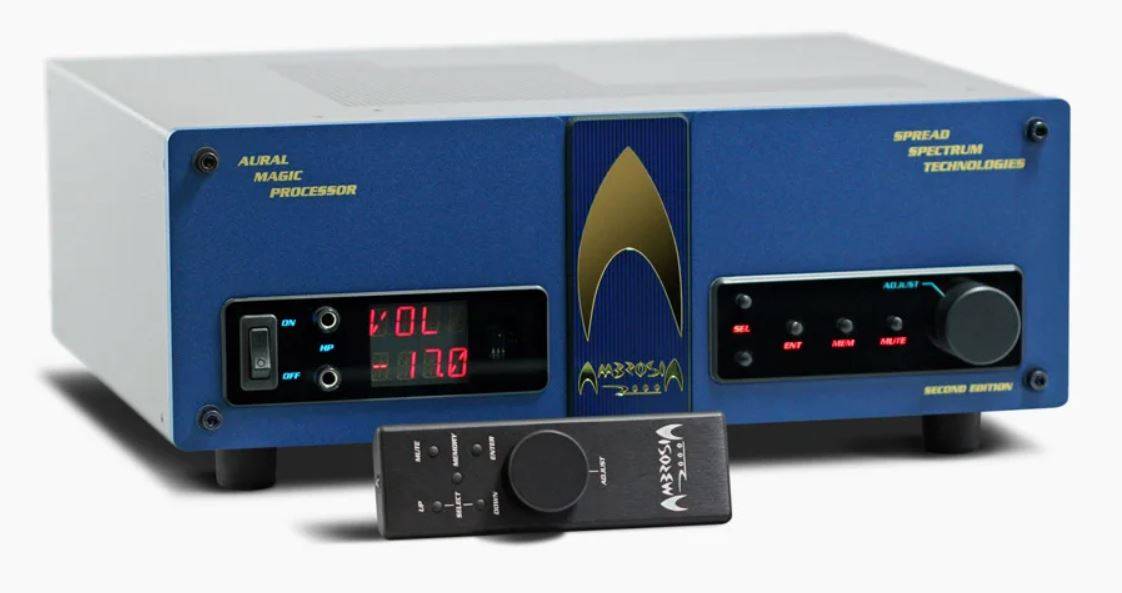
The small character I noticed in the original version of the Ampzilla 2000 is gone. That trace of forwardness in the upper midrange has been completely and utterly banished. With a signal/noise spec of -120dB, excellent low level resolution is assured. Given that the main speakers used for this review were the absolutely state-of-the-art, laboratory grade YG Acoustics Kipod II Signatures, I offer the following:
When I hear any sense of uneven frequency balance, where one part of the audible frequency spectrum is either forward or recessed, I will let you know.
When I hear any hint of uneven harmonic balance, such as a “thin” or threadbare sound in one part of the overall sound, for example, a rich and dense midrange with a thin treble, I will let you know.
When I hear complex music become congested or confused, I will let you know.
When I hear the soundstage offer less than outstanding width, depth, and height, I will let you know.
When I hear the sound field miss the ambience and overall size of the recording venue, I will let you know.
When I hear individual performers become flat “cardboard cutouts” or vague sources of sound, I will let you know.
When I hear these amplifiers have any sense of the negative connotations of “solid-state sound”, I will let you know.
In other words, when I hear these remarkable amplifiers doing anything – and I mean anything – wrong, I will let you know.
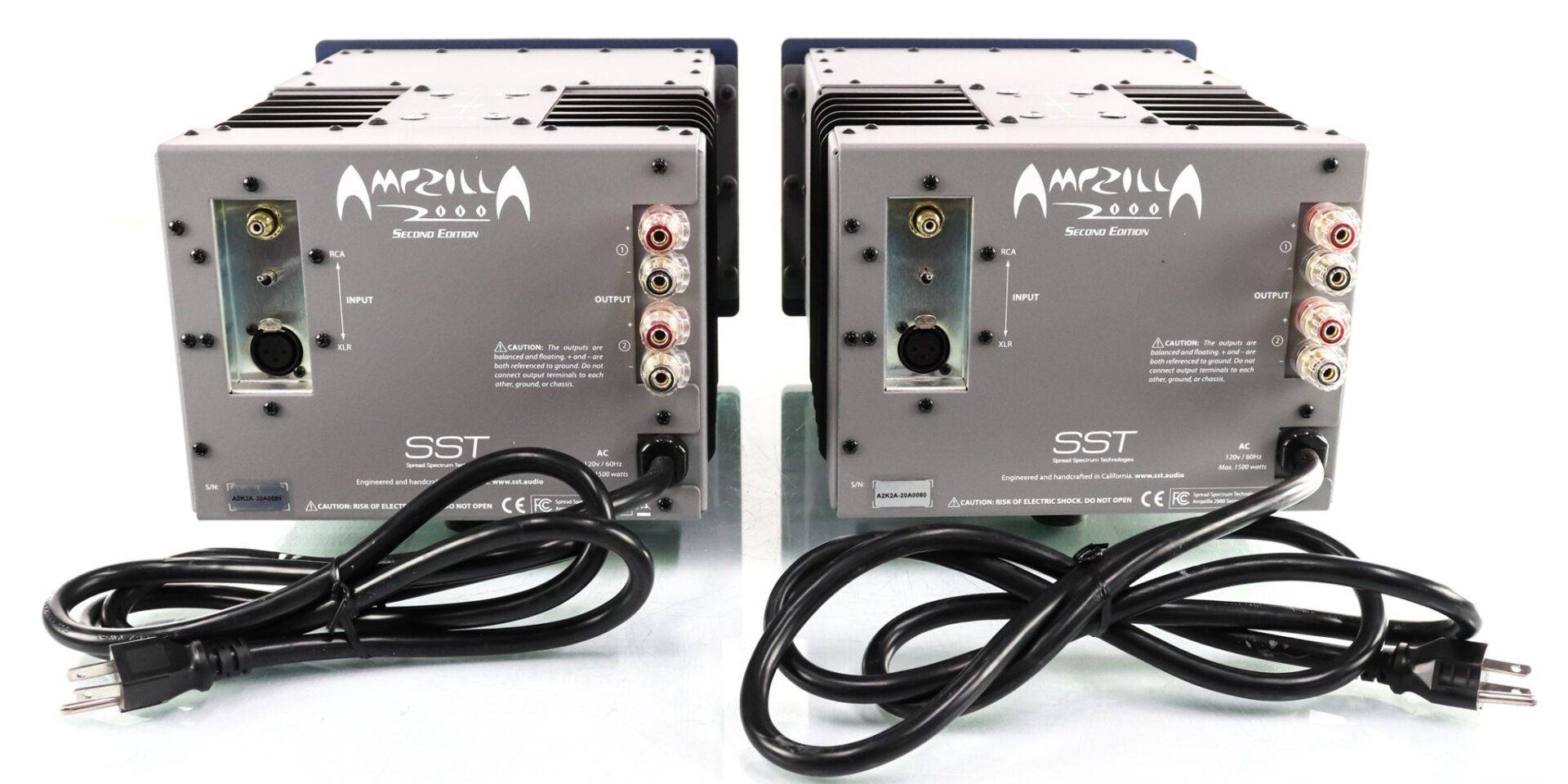
Hear ye, Hear ye! This is a game changing product. Vacuum tubes sound nice, but you will hear in short order how that “tube sound” really is a form of distortion that colors the music, giving it a false golden hue, obscuring and coloring upper frequency detail, and of course, reducing the resolution and impact in the bass. ALL of the sweet detail in the midrange and treble that we hear from good tube amplifiers is fully present with the Ampzillas, but without unwanted and incorrect additional baggage. Give these SST amps 200-300 hours of break in and your tube amps will be looking for a new home. And if you are like me, you will not miss wondering if your tube amps are going to blow a tube when you turn them on, harming your anticipated listening session. You will not miss that!
As I typed the preceeding paragraph I realized that the natural comparison for the solid-state Ampzilla 2nd Edition amplifiers is not to other solid-state amplifiers, but to vacuum tube amplifiers with their natural and lifelike sound. We take for granted the tubes’ wonderful harmonic depth and realistic presentation of voices and acoustic instruments, while accepting their almost universal weaknesses in the bass and upper treble. Eliminate those weaknesses, plus those noted above, and you have the Second Edition Ampzillas.
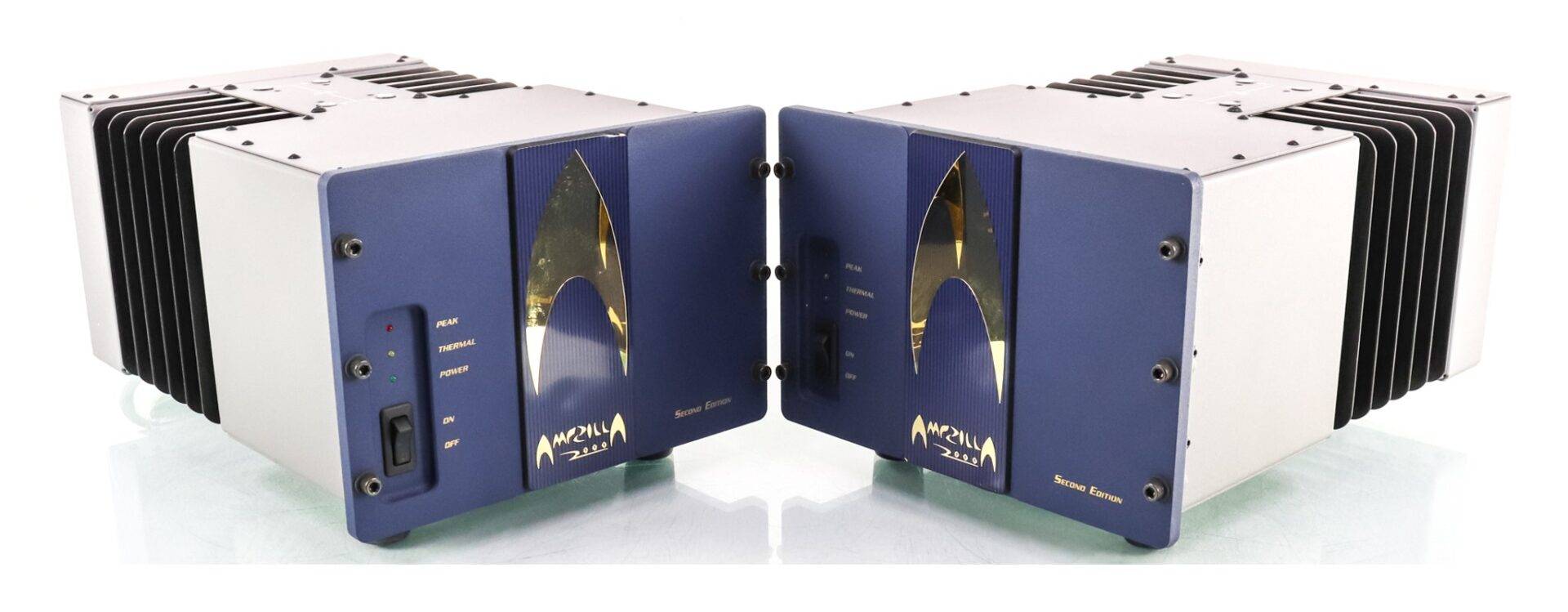
I am using my system much more since I installed the Ampzilla amplifiers several months ago. I don’t worry about “wasting” costly vacuum tubes with background music. I don’t worry about the electric bill with these running all day because they use only about 0.6 Amps (each chassis) at low volume levels. Compare that to the Parasound JC-1 which draws 4.8 Amps at LOW bias, or Krell FPB-300cx at 4.5 Amps. And most of all, I am not thinking about my next amplifier! The amplifiers have operated perfectly without any faults or strange behavior since installed.
The Spread Spectrum Technologies Ampzilla 2000 Second Edition power amplifiers are the most neutral and enjoyable sounding amps I have heard in my systems. My perfect amplifier would offer faultless sound, be affordable and easy to install, not heat the room, have no ongoing maintenance, and be inexpensive to operate. I believe that amplifier is in my listening room right now! If you are shopping in the $20k plus range, you will ignore these no matter how good they sound. For the rest of us, these are happy days! Live long and prosper.
Overall Rating: 10 LPs
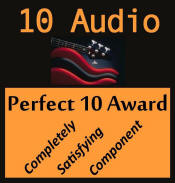
The Ampzilla and its progenitor, James Bongiorno are no strangers to a baby boomer audiophile such as myself. Originally conceived as a construction project for Popular Electronics Magazine, the Ampzilla’s reception was so overwhelmingly enthusiastic, that Bongiorno left his engineering position at SAE to found the Great American Sound Company (GAS) in 1974. A colorful character, and a musician at heart (be sure to check out his solo jazz piano on CD baby – an exceptional recording in my opinion), Bongiorno was influenced by Marantz’s Sid Smith, and had already put in a stint at Dynaco (the Dynaco 400 is his creation) before landing a job at SAE. It was here that he developed the dual differential fully complementary amplifier topology, which has proven to be a significant high-end design influence for over 30 years.
My first exposure to the Son of Ampzilla, the Ampzilla’s robust progeny, was in the mid 70s. Auditioned at a Myer Emco store, where it was partnered by Dahlquist DQ10 loudspeakers, the Son left a lasting impression. Here was a solid-state amplifier that was neither texturally grainy nor dynamically comatose, as was the case with my Citation 12, and could dish out far more detail and bass punch that I was accustomed to with the Dynaco ST-70. Not surprisingly, the Son went on to become a commercial success; apparently, tens of thousands of units were produced and sold. Proving how well built these units were, I’m told that most of these units are still in service today.
 Slowed down by a life-threatening illness, Bongiorno overcame the odds about five years ago and re-entered the high-end audio arena via Spread Spectrum Technologies. His first products to market were the Ampzilla and Son, 2000 series. The new Son is said to represent a third generation evolution of the original SAE-GAS designs, and incorporates several major improvements. First, it is completely balanced from input to output with full four-quadrant differential push-pull feedback from both sides of the speaker. Second, each channel features twice as many (and beefier) power transistors as the original. Unlike the original, the new Son is servo controlled. The power supply filter capacity has been increased three-fold to over 100,000 µF. In fact, the series name refers to the 2000 VA rating of the new power transformer. Finally, balanced/unbalanced input section is automatic. Adaptors are included that allow the XLR connectors to accept RCA plugs. Output devices are still bipolar types.
Slowed down by a life-threatening illness, Bongiorno overcame the odds about five years ago and re-entered the high-end audio arena via Spread Spectrum Technologies. His first products to market were the Ampzilla and Son, 2000 series. The new Son is said to represent a third generation evolution of the original SAE-GAS designs, and incorporates several major improvements. First, it is completely balanced from input to output with full four-quadrant differential push-pull feedback from both sides of the speaker. Second, each channel features twice as many (and beefier) power transistors as the original. Unlike the original, the new Son is servo controlled. The power supply filter capacity has been increased three-fold to over 100,000 µF. In fact, the series name refers to the 2000 VA rating of the new power transformer. Finally, balanced/unbalanced input section is automatic. Adaptors are included that allow the XLR connectors to accept RCA plugs. Output devices are still bipolar types.
 Bongiorno, whose fashion sense is, let’s say, a bit unconventional, chose a blue finish for the fascia of the new Ampzillas. Since several pundits declared this a fashion faux pas, the Son is now available in an optional and more conventional black finish. However, for the record, I love the blue and my sample of the Ambrosia is finished in matching blue. On the other hand, the Bonge, as his friends call him, has always had a knack for picking catchy product names. My favorite example is the GAS “Charlie the Tuner” — a takeoff on Charlie the Tuna, the cartoon mascot for StarKist Tuna.
Bongiorno, whose fashion sense is, let’s say, a bit unconventional, chose a blue finish for the fascia of the new Ampzillas. Since several pundits declared this a fashion faux pas, the Son is now available in an optional and more conventional black finish. However, for the record, I love the blue and my sample of the Ambrosia is finished in matching blue. On the other hand, the Bonge, as his friends call him, has always had a knack for picking catchy product names. My favorite example is the GAS “Charlie the Tuner” — a takeoff on Charlie the Tuna, the cartoon mascot for StarKist Tuna.
The cornerstone of this review article is the Ambrosia preamplifier, Bongiorno’s latest product offering, and one that he believes breaks new ground. The Son is in the review loop because Bongiorno had asked that the Ambrosia be reviewed in combination with the Son. However, I felt that it was also important to listen in the context of several other amplifiers to establish a more complete sonic profile.
Technical Details
 A total of about 10 man-years of development effort has gone into the Ambrosia, and as you will shortly find out, it indeed represents a complicated and ambitious undertaking. The Ambrosia is intended as a full function preamplifier, and to paraphrase Vinny Gambini (My Cousin Vinny the movie), I’m sure you’ll be ‘mooore’ than satisfied with its functionality. For starters, separate MM and MC phono stages are included. Each phono circuit has its own switchable and dedicated low cut 20Hz filter featuring a quasi fourth order phase-equalized network.
A total of about 10 man-years of development effort has gone into the Ambrosia, and as you will shortly find out, it indeed represents a complicated and ambitious undertaking. The Ambrosia is intended as a full function preamplifier, and to paraphrase Vinny Gambini (My Cousin Vinny the movie), I’m sure you’ll be ‘mooore’ than satisfied with its functionality. For starters, separate MM and MC phono stages are included. Each phono circuit has its own switchable and dedicated low cut 20Hz filter featuring a quasi fourth order phase-equalized network.
The line amplifier is fully balanced and uses JFETs and Analog Devices AD797 opamps in a topology that is said to generate essentially zero distortion. The line amplifier incorporates sophisticated bass and treble tone controls with four selectable inflection points. Tone controls?! Now that’s something you almost never find in a high-end preamplifier, and I totally agree with Bongiorno that it’s an indispensable feature in tuning one’s system, since as he points out, “there is no such thing as a flat room.” In addition, I might add that fine-tuning a speaker’s tonal balance is also a possibility, especially critical in the frequency range below 300 Hz where so many modern designs are anemic sounding. Finally, since Bongiorno is big on headphone listening, expect no less than a pair headphone jacks on the front panel which can deliver several hundreds milliwatts into even very low impedance cans. The headphone driver is very good; my Grado RS-1 cans were driven cleanly and with plenty of headroom.
 There are plenty of unbalanced inputs, two balanced inputs, and two tape loops. Both RCA and XLR output jacks are provided. This is a heavy chassis; at 50 pounds, it outweighs many power amplifiers, including the Son. Most of the weight is due to a huge low EMI power transformer mounted in its own can. It features four secondary windings that are used to power each circuitry section independently, and in the process eliminate ground loops. In addition, 15 independent power supply regulators are employed throughout for immunity against AC mains fluctuations. The level of finish is superb: all metal surfaces, including the front panel, are powder coated. All of this is clearly fitting for a device that references Greek mythology. Ambrosia, the food of the G-ds, was thought to confer immortality, and in this context, presumably celestial sonic delight.
There are plenty of unbalanced inputs, two balanced inputs, and two tape loops. Both RCA and XLR output jacks are provided. This is a heavy chassis; at 50 pounds, it outweighs many power amplifiers, including the Son. Most of the weight is due to a huge low EMI power transformer mounted in its own can. It features four secondary windings that are used to power each circuitry section independently, and in the process eliminate ground loops. In addition, 15 independent power supply regulators are employed throughout for immunity against AC mains fluctuations. The level of finish is superb: all metal surfaces, including the front panel, are powder coated. All of this is clearly fitting for a device that references Greek mythology. Ambrosia, the food of the G-ds, was thought to confer immortality, and in this context, presumably celestial sonic delight.
The Ambrosia is fully menu driven. Its front panel is dominated by a large, bright display that is visible from a distance. Functions are accessed via the ‘select’ buttons and individual options within each menu grouping are accessible with the optical encoder knob. For a selection to take effect it needs to be entered into memory, the display then defaults back to Volume and the encoder knob may be used to make level adjustments in 0.5 dB steps. It was considered absolutely mandatory to design a remote controlled unit and to do so in a manner that does not involve a “gazillion” remote buttons, which naturally tend to be a major pain. Thus, the remote is a carbon copy of the unit’s front panel. The only difference between the two is that that a mechanical (rather than optical) encoder is used on the remote in order to save battery power. The volume control consists of an integrated chip audio attenuator whose output is digitally controlled. All switching is performed via 11 programmable CMOS integrated chips, with each chip providing 16 sets of analog switches. However, and this is important, there are no digital circuits or digital processing in the signal path, which is totally analog. The digital control firmware only wakes up when a function is accessed. By firmware I mean a software program that is resident in a read-only memory (ROM) integrated chip It is possible to hear a faint “click” when accessing a function or changing volume levels and. This is normal and cannot be fully eliminated with this type of control firmware.
Shortly after the initial production run, and mainly to appease the Japanese and other aficionados of high-efficiency speakers, an “attenuation” function was added which is accessible from the filter options section of the menu. This firmware change provides a -14dB level cut and may be applied if desired to all inputs or to a particular phono input. Of course, ‘attenuation’ should not be invoked when it is not needed, which would be the case for most users. It takes about 30 minutes for the Ambrosia to reach optimum performance and really start singing, but Bongiorno sees no reason (an neither do I) to leave the unit on continuously.
Sonic Impressions
Metaphorically speaking, a preamplifier is the spark plug of an audio system. It has the potential to jump-start the audio signal and set the stage for the power amp. But because it sits at the head of the amplification chain it can also imprint its personality on each and every input signal. Virtually every preamp I have reviewed over the past 25 years has been vacuum tube based. At the risk of sounding like a tube supremacist, I would like to point out that there is a reason for why tubes have ruled preamp land. Tubes have always had the gift of microdynamics, harmonic textures and spatiality. They have been able – far more convincingly than transistors — of dishing out the music’s emotional content and drama as well as fleshing out believable instrumental timbres and soundstage dimensions. Transistors have had bass, detail resolution, and low noise to brag about, but in my book ‘enjoying the music’ counts for far more than accurate sterility. The notion that tube magic is partially due to euphonic colorations of the signal does not bother me at all. Because above all else, I value the ability to connect with the music’s message. J. Gordon Holt’s ‘Goose Bump’ test is still as valid today as it was 50 years ago. By the way, his favorite preamp was the Marantz 7, which went on to become a classic. It was only in the past couple of years that my respect for solid-state preamplification took a leap forward. It started with the GamuT D3, and now the Ambrosia.
Vinyl playback through the internal Moving Magnet (MM) stage provided superlative sound quality. No, I didn’t experiment with the Moving Coil (MC) stage since for the past six months I’ve been living quite happily with my Grado Reference MM cartridge and hence I’ve had little incentive to tinker with a winning setup. The rest of the phono system components have been fixtures in my system for several years, namely the Graham 2.5 arm and the Kuzma Reference table. Most of the analog listening sessions were conducted with the Venture Audio Excellence III loudspeakers. For starters, I used the LAMM Industries M1.2 Reference monoblock power amplifiers, a hybrid design, and a synergistic match for the Venture Audio speakers. At least in my listening room, these speakers sound a bit too lean to suit my taste in the lower midrange/upper bass range. The Ambrosia’s tone controls gave me the opportunity to tweak the speaker’s tonal balance to my liking. A +2dB lift below a hinge frequency of 270Hz did the trick. I also experimented with the 20Hz bass-cut filter but did not like its impact on mid bass timbre, which lost body weight. Generally, in the case of bass-reflex loaded speakers, an infrasonic filter is a good idea as woofer loading is lost below the bass box tuning frequency. Any problem with arm resonances or turntable rumble will cause severe cone pumping and produce associated Doppler distortion of higher frequencies. Perhaps the cut frequency needs to be lowered a bit, but in any event, I decided to bypass the low cut filter.
The music’s harmonic tapestry was remarkably silky and yet exquisitely detailed. The soundstage was solidly fleshed out with an excellent depth perspective and extremely stable image placement. Most telling was the manner in which vinyl surface noise, clicks and pops, were dispensed with. They disappeared so quickly, and with such a fast time signature, that their annoyance level was greatly reduced. This speaks volumes for the Ambrosia’s transient response. Both the leading edge and decay portion of each transient were clearly enunciated, allowing low-level detail to naturally bubble to the surface. But just like the real thing, textures were not outrageously detailed. Some preamps flaunt it in your face with enough brightness and dissonant sizzle to fry eggs. The Ambrosia follows a different sonic path. Its low distortion signature and superlative transient response were responsible for a fluid delivery and enhanced clarity. Although microdynamics were reproduced very well indeed, I did notice a slight contraction of emotional intensity relative to my current reference, the Concert Fidelity CF-080 line preamplifier and the Air Tight ATE-2 phono stage. Just as a reminder, these findings were generated with the M1.2 Reference amplifier in the chain. In this context, the Ambrosia did nothing to detract from the overall perception of first-rate bass extension and pitch definition.
 The Son of Ampzilla had already spent some time in my system prior to the arrival of the Ambrosia driving both the Final Sound 1000i ESLs and the Esoteric MG-20 with its cast of all-magnesium alloy drivers. It became clear that it was totally unphased by difficult loads. And because of its low source impedance it did not roll off the Final Sound ESL’s treble, even though the latter approaches an impedance of 1 Ohm at 20kHz. Its sonic character was always smooth and never offensive at any drive level. Bongiorno coined the term ‘Tubistor’ to characterize its sound, since the Son’s smooth distortion characteristics, according to James, recall the sound of vintage tube amplifiers. However, on the debit side of its report card were the observations that the Son was tonally a bit laid back through the midrange and that it lacked in soundstage transparency (read: slightly veiled) relative to the two, albeit much more expensive, amplifiers in the house — the LAMM Industries M1.2 Reference and Silicon Arts Design ZL-120. Enter the Ambrosia. Partnering the Son and driving the Venture Audio speakers, transparency, that is illumination of the inner recesses of the soundstage, was judged to be very good during vinyl playback. In addition, bass control was exceptional, and harmonic textures were consistently smooth and liquid in character — most unusual for a solid-state amp. Yes, the Son could be bested in terms of immediacy, emotional intensity, and soundstaging, but at a much higher price point.
The Son of Ampzilla had already spent some time in my system prior to the arrival of the Ambrosia driving both the Final Sound 1000i ESLs and the Esoteric MG-20 with its cast of all-magnesium alloy drivers. It became clear that it was totally unphased by difficult loads. And because of its low source impedance it did not roll off the Final Sound ESL’s treble, even though the latter approaches an impedance of 1 Ohm at 20kHz. Its sonic character was always smooth and never offensive at any drive level. Bongiorno coined the term ‘Tubistor’ to characterize its sound, since the Son’s smooth distortion characteristics, according to James, recall the sound of vintage tube amplifiers. However, on the debit side of its report card were the observations that the Son was tonally a bit laid back through the midrange and that it lacked in soundstage transparency (read: slightly veiled) relative to the two, albeit much more expensive, amplifiers in the house — the LAMM Industries M1.2 Reference and Silicon Arts Design ZL-120. Enter the Ambrosia. Partnering the Son and driving the Venture Audio speakers, transparency, that is illumination of the inner recesses of the soundstage, was judged to be very good during vinyl playback. In addition, bass control was exceptional, and harmonic textures were consistently smooth and liquid in character — most unusual for a solid-state amp. Yes, the Son could be bested in terms of immediacy, emotional intensity, and soundstaging, but at a much higher price point.
Initially, I was less enamored with this partnership during CD playback, at least when feeding the Esoteric SA-60 analog output through the Ambrosia’s line stage. However, late in the ball game, the PrimaLuna ProLogue Eight CD player (with the Super I/V Board Plus upgrade) joined the fun. Revisiting the Ambrosia plus Son of Ampzilla combination, I was shocked by what now could best be described as superlative soundstage transparency. Image outlines were tightly focused within an expansive soundstage. Detail resolution and clarity now rivaled far more expensive amplification chains. This in essence is the definition of synergy; the sum being greater than the individual parts.
Conclusions
Ampzilla lives again! It would appear that James Bongiorno is still riding tall in the saddle. Part musician and part audio magician, and a national treasure in my humble opinion, Bongiorno delivers the goodies yet again. While the Son of Ampzilla represents a safe recommendation at its price point (and for the record, I’m a proud owner of a Son), the Ambrosia is a sensation at any price point. Here is a full function preamplifier complete with MM and MC phono capability that for me bridges the sonic gap between solid-state and tube designs. If you already own a tube or hybrid amp, the Ambrosia should prove most complementary. With a tubed CD player, such as the PrimaLuna ProLogue Eight at the head of the chain, the Ambrosia-Son partnership partnered makes for a synergistic amplification chain competitive with the best money can buy.
Follow Up
It happened in Las Vegas, but it certainly did not stay there. I was seated late one evening in the VMPS Audio room at the St. Tropez during the January 2008 CES, simply enjoying the music, when Brian Cheney turns to me and says something to the effect that I should give a pair of Son of Ampzilla (SofA) a listen in monoblock configuration. He already knew that I was in the process of evaluating the SofA as a stereo amplifier and indicated that as monoblocks they sound much different.
It took some time for James Bongiorno to send me another SofA, and eventually I spent most of April evaluating a pair as monoblocks. It is important to note that SofA is a bridged amp so it cannot be bridged again, but simply using a single channel in each of two amps gives not only a power increase but also improved sound quality. In fact, when I asked Brian why he tried this configuration in the first place he said that he wanted more power and estimated the power increase as about 40% in monoblock configuration.
I have to confess that I was totally unprepared for a dramatic leap in sonic refinement. A clear demonstration of the power of two: a pair of SofA sounded at least factor of four better. What was truly amazing was the change in sonic personality. The presentation gained considerable immediacy with more treble air. Dynamics, and especially macrodynamics, as in the surge from loud to very loud, were more convincing. In addition, rhythmic drive, aka the boogie factor, was more pronounced, all in all making for a persuasive emotional connection with the music. Soundstage depth perspective was deeper and better layered. Image focus also improved noticeably. Brain Cheney believes that channel crosstalk is always a problem in stereo amps, especially at high frequencies, and impairs imaging. The monoblock configuration, he says, takes care of that.
During a period of several weeks I auditioned the SofA monoblocks with some of my favorite loudspeakers, including the TEAC Esoteric MG-20, the Venture Audio Excellence III Signature, and the Final Sound 1000i electrostatics. In every case, the SofA performed flawlessly. It became apparent as I changed preamps and front ends that this was essentially a neutral sounding amp that strictly mirrored the sonic flavor of what came before. The SofA could be made to sound tube-like, at least through the midrange, by a good tube preamp, while the increase in speed with a solid-state preamp in the chain was clearly noticeable.
At the end of this period I realized that I could no longer live without the reliability, purity of tone, and bass horsepower offered by the SofA monoblocks. In my opinion the SofA twins are more than competitive with any power amp on this planet. Considering their asking price, they truly are a bargain in high-end terms.
Description
FEATURES The entire amplifier circuit (except the power output stages) is contained on one main drive card which also contains the input jacks. This ensures that the amplifier is upgradeable with future circuit improvements 100% stable at any load angle 0-90 degrees, capacitive or inductive, regardless of wave shape.
Extremely capable 300 watts into 8Ω
Fully balanced design
Protection power switch/circuit breaker Four DC power supply fuses with indicators
All-steel 14 gauge chassis with powder coat finish Front panel “Peak”, “Thermal” and “Power” LED indicators
Turn-on delay and surge relay protection
Custom-designed power transformers, constructed domestically
Highest quality gold plated input and output jacks
Gold plated internal connectors
Captive 12 gauge power cord with welded connectors
AMPLIFIER SPECIFICATIONS
Power Rating 8Ω: Minimum 300 watts, 20Hz–20kHz
Input Impedance and Sensitivity Unbalanced: ± 1 V RMS across 50kΩ for 300 watts into 8Ω Balanced: ± 1 V RMS across ± 70kΩ for 300 watts into 8Ω
Frequency Response and Power Bandwidth at Rated Power 8Ω: Better than ± .2 dB 20Hz–20kHz THD and IM Distortion Less than .05% @ any power level up to rated at any frequency or combination of frequencies between 20Hz–20kHz
Damping Factor Greater than 250 @ 20Hz
Noise Better than -120dB relative to full rated power
Gain 26dB (balanced and unbalanced input)
Weight 58 lbs.
Dimensions 14 ⅜” L x 11″ W x 7 ½” H
Stereo preamplifier Specifications
Gain: MC: 64dB max; MM: 42dB; Line: 21dB
THD (MC & MM): <0.05%, 20 Hz to 20 kHz at 2 V at tape out
THD (Line): <0.05%, 20 Hz to 20 kHz at 2 V at main out
Input impedance: MC nominally 1 kOhm; MM nominally 47 kOhm; line inputs nominally 40 kOhm
(Balanced: +/- 50 kOhm balanced; Unbalanced: 50 kOhm)
Weight: 50 lbs.
Price: $7,500





